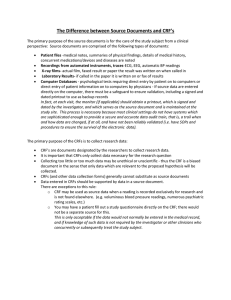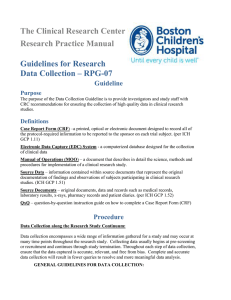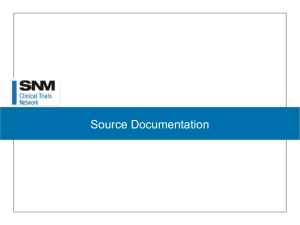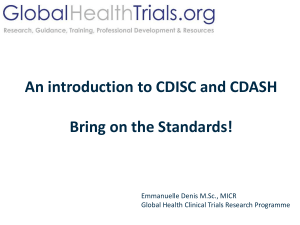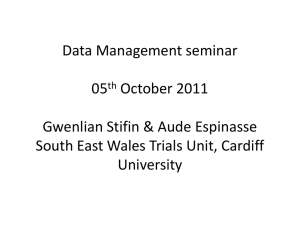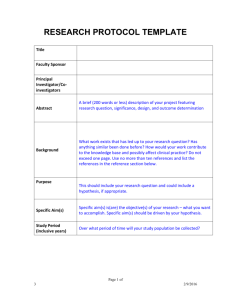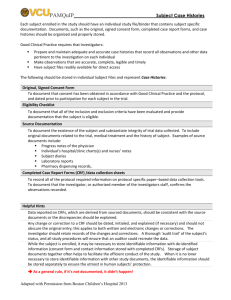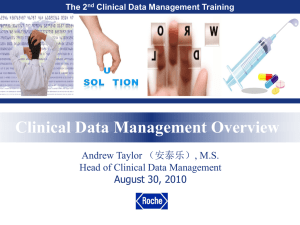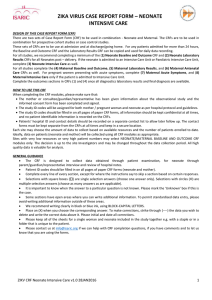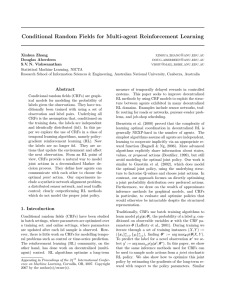Source Documents & CRFs in Clinical Trials
advertisement
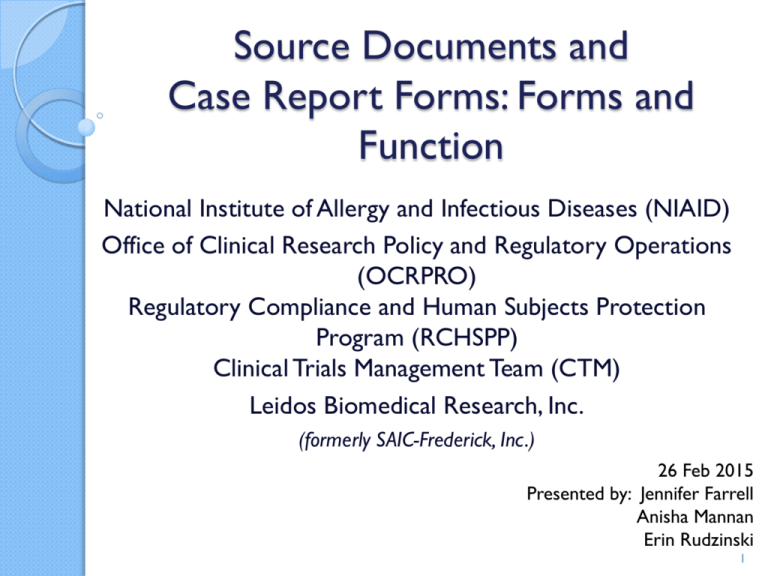
Source Documents and Case Report Forms: Forms and Function National Institute of Allergy and Infectious Diseases (NIAID) Office of Clinical Research Policy and Regulatory Operations (OCRPRO) Regulatory Compliance and Human Subjects Protection Program (RCHSPP) Clinical Trials Management Team (CTM) Leidos Biomedical Research, Inc. (formerly SAIC-Frederick, Inc.) 26 Feb 2015 Presented by: Jennifer Farrell Anisha Mannan Erin Rudzinski 1 Purpose To review definitions of Source Documents and Case Report Forms Provide information regarding the function of each document To clarify when each document is to be used 2 Source Documents 3 Source Documents “Source documentation is the beginning of a clean, verifiable audit trail.” Good Clinical Practice: A Question & Answer Reference Guide, May 2010 4 Source Documents Source Documents: • Original documents, data and records or certified copies of original records of clinical findings, and observations. Examples: • • • • Signed informed consent forms Hospital records Clinical charts Laboratory reports 5 Source Documents Source documents are: • Records on which clinical observations are first recorded • Legally valid • Raw data • Support the study’s findings • Signed and dated by person completing Together with CRFs, comprise “case histories” 21 CFR 312.62(b), Good Clinical Practice: A Question & Answer Reference Guide, May 2010 6 Source Documents Electronic Source Documents/Data • Any combination of text, graphics, data, audio, pictorial, or other information represented in digital form that is created, modified, maintained, archived, retrieved, or distributed by a computer system [21 CFR 11.3(b)(6)]. • Initially recorded in electronic format. 7 Source Documents Electronic Source Documents/Data • eSource documents and eSource data can come from a variety of activities and places. • A list of all authorized data originators should be developed and maintained by the sponsor and site. Data originators entering source data can be: Persons Systems Devices Instruments FDA Guidance for Industry: Electronic Source Data in Clinical Investigations, September 2013 8 Source Documents Maintain Adequate and Accurate Records • GCP Expectations: Record observations and all pertinent study related data. At a minimum, capture as part of a subject’s record: Demographic information Study selection criteria Information to support data Exposure to study drug 9 Source Documents Apply the ALCOA standard to achieve data quality: • Attributable • Legible • Contemporaneous • Original • Accurate 10 Source Documents Standardized forms– same across multiple studies. • Examples: demographics, history, and physical examination. Study specific forms– designed to meet data needs for a specific protocol, diseases entities or time points. • Examples: laboratory data, inclusion/exclusion criteria, participant symptom assessments, specific tumor disease/typing, etc. 11 Source Documents Corrections/Changes to Source Documents Error Noted Do’s Don’ts • Scribble over mistake • Make a single line through original entry and initial/date • Correction correction (with current needed on original date) source document • Keep original information clearly visible • Missing data located at a later date • Incorporate into research record with current date • Use White Out/Tape • Re-write over top of entry • Destroy originals • Alter past-dated notes (by writing alongside or adding to prior entries) • Ignore • Backdate information 12 Source Documents Common Issues Noted • Source Document/Data is unavailable • Source Documentation is incomplete or missing. • Results of study related procedures not documented. • Investigator/designee did not sign/date form as required. • Adverse Events recorded in progress notes were not reported in the study data. • Discrepancies between source documentation and CRFs/eCRFs. 13 Case Report Forms 14 Case Report Forms What is a Case Report Form (CRF)? • A printed, optical, or electronic document designed to record all of the protocol-required information to be reported to the sponsor on each trial subject. • Provided by the sponsor. • Must be checked against the source document. • Information applies to both paper and electronic CRFs ICH GCP E6 1.11 15 Case Report Forms Examples: • • • • MiForm ClinPlus 3-part NCR paper Single-sheet Paper 16 Case Report Forms Purpose of CRFs • Capturing all protocol-required information. • Facilitates data collection and entry. • Benefits data management and statistical analysis. • Promote data sharing between the study team and other institutions. ICH GCP E6 5.23.2 17 18 Case Report Forms CRF Completion • Ensure the accuracy, completeness, legibility, and timeliness of the data reported in the CRFs. • Data reported on the CRF should be consistent with the source documents. • Initial and date the completed form. • Any change or correction to a CRF should be dated, initialed, and explained (if necessary) and should not obscure the original entry. ICH 8.3.14 & ICH GCP E6 4.9 19 Case Report Forms Study Status Change/End-of-Study/Final Status CRF • The PI must sign this form after all the CRFs for the subject are complete and reviewed by the PI. 20 21 Case Report Forms Design • Data are collected as outlined in the protocol. • User-friendly and uncluttered. • Clear instructions for completion. • Avoid duplication of data. 22 Case Report Forms as Source Documents 23 Source Documents and CRFs Tying everything together • Source Document • CRF What about when the documents overlap? 24 Case Report Forms as Source Documents Per ICH GCP, CRFs or portions of CRFs may serve as source documents. Therefore, the CRF now has 2 functions: 1. Part of medical record (first point of entry) 2. Data collection tool 25 Case Report Forms as Source Documents When CRFs or portions of CRFs serve as source documents: • The protocol should prospectively define which data may be treated in this way. • Sections of the CRF also functioning as source documents should be: • Signed and dated by the person collecting that information. ICH GCP E6 6.4.9 26 27 Case Report Forms as Source Documents Remember! When using CRFs as source (paper OR electronic) • Any regulatory agency can request more information for evidence of testing or diagnosis • “When pertinent supportive information is available, FDA could request other documents during an inspection to corroborate a direct entry of source data elements into the eCRF by an authorized data originator.” FDA Guidance for Industry: Electronic Source Data in Clinical Investigations, September 2013 28 Quick Reference Guide Document Signature or Initials? Why? Source Document Signature and Date Data is attributable to person completing procedure; also part of a medical record; hospital documentation/ accreditation requirement CRF Initials and Date Data is attributable to authorized study member Entire CRF is also Source Document Signature and Date Both CRF and Source Document requirements apply Part of CRF is Source Document, Part is CRF Signature and Date on Both CRF and Source Source section; Document requirements Initial/date CRF portion apply 29 Case Report Forms as Source Documents Worksheets • • • • Act in a similar manner to source documents. Not original source – secondary source. Not CRF (even though it may look like one). Used to facilitate data entry. 30 Conclusion Source Documents (Site) Case Report Forms (Site) Source Document Verification (Monitor) Database Locked & Clean-Up (DCC) Analysis, Auditing, and Reporting (Statisticians) Final Study Report (Site & Sponsor) Regulatory Agencies (DHHS, FDA, IRB, DSMB) 31 Any questions or comments? This project has been funded in whole or in part with federal funds from the National Cancer Institute, National Institutes of Health, under Contract No. HHSN261200800001E. The content of this publication does not necessarily reflect the views or policies of the Department of Health and Human Services, nor does mention of trade names, commercial products, or organizations imply endorsement by the U.S. Government. 32 References ICH GCP E6 http://www.fda.gov/downloads/Drugs/Guidances/uc m073122.pdf Good Clinical Practice: A Question & Answer Reference Guide, May 2010 FDA Guidance for Industry: Electronic Source Data in Clinical Investigations, September 2013 http://www.fda.gov/downloads/drugs/guidancecompl ianceregulatoryinformation/guidances/ucm328691.p df www.fda.gov 33
